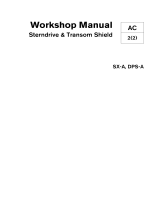Page is loading ...

1. Placement
To avoid compass error, place the
WEATHERPAK
®
M
1
at least 30 meters (99 feet),
laterally, from any mass of steel (trucks, buildings,
etc). For vehicle mount applications, 3 meters (10
feet) above the vehicle is acceptable.
2. Tripod setup
1. Insert and lock the legs onto the bottom
section of the tower, forming the tower tripod
base.
2. Align the slot on the WEATHERPAKM with the
guide pin on the quick release and push
straight in. The cam lock provides a precision
sealed fit and may require an extra push to
seat the WEATHERPAKM properly.
CAUTION:
DO NOT screw the WEATHERPAKM onto
the cam lock connector.
© 2020
Campbell Scientific, Inc.
Part Number: 38109
November 24, 2020
WEATHERPAK®M
Quick Deploy Guide

3. Once the weather station is properly seated,
press the arms of the cam lock down to assure
a tight fit. The battery indicator light (on the
tower junction box) should illuminate when
the WEATHERPAKM is properly seated into
the cam lock.
4. Place the entire unit (upper tower section and
WEATHERPAKM) onto the tripod, engage the
twist-lock and turn clockwise a quarter turn.
5. The WEATHERPAKM is now running and
sampling data. When the WEATHERPAKM is
removed from the cam lock connector, it will
stop sampling and shut itself off.
3. INTERCEPT display setup
1. Connect the external GPS and radio antennas
to the appropriate connectors on the side of
the INTERCEPT®
2
display.
FIGURE 3-1. Side of INTERCEPT display
2. When outputting data to the
CAMEO®/ALOHA®
3
plume modeling
software, connect the USB to serial data cable.
(The Ethernet connection will only be used in
rare instances where the INTERCEPT display
will be connected to a network).
3. Plug the INTERCEPT display power supply into
an AC power source then insert the power
supply barrel connector into the power jack on
the bottom of the display and tighten.
FIGURE 3-2. Bottom of INTERCEPT display
4. The power indicator light on the bezel
illuminates as the display starts up. The
INTERCEPT application will automatically
launch and begin receiving data from any
WEATHERPAKM units available.
FIGURE 3-3. Front of INTERCEPT display
WEATHERPAK M Quick Deploy Guide | November 24, 2020 2

4. Battery replacement
5. WEATHERPAKM and ALOHA
software
The following presents the basic operation of
ALOHA with the WEATHERPAK M. Campbell
Scientific recommends consulting the ALOHA
website and/or a certified CAMEO/ALOHA instructor
for training, program details, and limitations.
1. Click the ALOHA desktop icon or select
ALOHA from the Windows® Programs menu.
An Air Model Limitations dialog box will
appear with important notes on program
limitations. Read and click OK.
2. Confirm that your Site Data information
provided in the Text Summary window is
correct. If required, use the SiteData drop-
down menu to change data.
3. Go to SetUp > Chemical and select the
appropriate chemical.
4. Select SetUp > Atmospheric > SAM Station to
display series of dialog boxes that require user
observations or assumptions.
NOTE:
Relative humidity is not captured
automatically by the ALOHA model but
may be entered manually using data from
the WEATHERPAKM display.
5. (Optional) To confirm that WEATHERPAKM
data is being delivered to ALOHA, go to SAM
Options > Processed Data and the Processed
SAM Data window will display the data
delivered to ALOHA.
NOTE:
The user gets a warning message in both
the Text Summary and Processed SAM
Data windows if the WEATHERPAKM has
been collecting data for less than five
minutes.
6. ALOHA requires the SAM station to be
operating for five minutes before selecting the
source of release (tank, pipe, direct, etc.). Go
to SetUp > Source and select the leak source
such as tank. A series of dialog boxes will
appear requiring user observations or
assumptions.
7. Select Display > Threat Zone and the Level of
Concern window will display the default ERPG
ranges. Select OK to show the plume footprint.
Displaying the footprint in ALOHA is essential
before the plume can be overlaid on a
MARPLOT® or other street map.
8. (Optional) Select the Display menu to produce
graphs for source strength and concentration.
FIGURE 5-1. ALOHA window
WEATHERPAK M Quick Deploy Guide | November 24, 2020 3

9. Select the Sharing menu to plot the plume
onto a MARPLOT (or other) map. As weather
conditions change, the plume size and
position will change on the map, shortly after
the WEATHERPAKM provides updated data.
NOTE:
MARPLOT software requires that the
ALOHA window overlay the map window
for the map-plume to update
automatically.
FIGURE 5-2. ALOHA with MARPLOT map
6. Decontamination
Decontaminate the WEATHERPAK system while fully
assembled on tripod tower.
7. Reference
1
WEATHERPAK is a registered trademark of
Campbell Scientific.
2
INTERCEPT is a registered trademark of Campbell
Scientific.
3
Both ALOHA and CAMEO are registered by
National Oceanic and Atmospheric Administration
(NOAA) U.S. Department of Commerce FEDERAL
AGENCY UNITED STATES.
WEATHERPAK M Quick Deploy Guide | November 24, 2020 4

Australia
Location:
Phone:
Email:
Website:
Garbutt, QLD Australia
61.7.4401.7700
info@campbellsci.com.au
www.campbellsci.com.au
Brazil
Location:
Phone:
Email:
Website:
São Paulo, SP Brazil
11.3732.3399
vendas@campbellsci.com.br
www.campbellsci.com.br
Canada
Location:
Phone:
Email:
Website:
Edmonton, AB Canada
780.454.2505
dataloggers@campbellsci.ca
www.campbellsci.ca
China
Location:
Phone:
Email:
Website:
Beijing, P. R. China
86.10.6561.0080
info@campbellsci.com.cn
www.campbellsci.com.cn
Costa Rica
Location:
Phone:
Email:
Website:
San Pedro, Costa Rica
506.2280.1564
info@campbellsci.cc
www.campbellsci.cc
France
Location:
Phone:
Email:
Website:
Vincennes, France
0033.0.1.56.45.15.20
info@campbellsci.fr
www.campbellsci.fr
Germany
Location:
Phone:
Email:
Website:
Bremen, Germany
49.0.421.460974.0
info@campbellsci.de
www.campbellsci.de
India
Location:
Phone:
Email:
Website:
New Delhi, DL India
91.11.46500481.482
info@campbellsci.in
www.campbellsci.in
South Africa
Location:
Phone:
Email:
Website:
Stellenbosch, South Africa
27.21.8809960
sales@campbellsci.co.za
www.campbellsci.co.za
Spain
Location:
Phone:
Email:
Website:
Barcelona, Spain
34.93.2323938
info@campbellsci.es
www.campbellsci.es
Thailand
Location:
Phone:
Email:
Website:
Bangkok, Thailand
66.2.719.3399
info@campbellsci.asia
www.campbellsci.asia
UK
Location:
Phone:
Email:
Website:
Shepshed, Loughborough, UK
44.0.1509.601141
sales@campbellsci.co.uk
www.campbellsci.co.uk
USA
Location:
Phone:
Email:
Website:
Logan, UT USA
435.227.9120
info@campbellsci.com
www.campbellsci.com
Campbell Scientific regional offices
/



